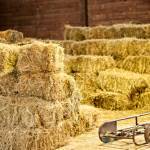Beyond Hay: Chaff and Haylage for Horses

Chaff is simply chopped forage, often with added molasses to minimise dust or oil to increase the energy value. Chaff is fed to horses in England, New Zealand, South Africa, Southeast Asia, and Australia, but it is not a common feed elsewhere in the world.
Traditionally, chaff was a method of feeding poor-quality forage such as straw in a form that was appealing to the horse. The length of the chop varies from 1 to 3 cm (1 to 1.5 inch), depending on where in the world it is made.
Chaff adds bulk to a diet without providing too many calories, and keeps the stabled horse busy eating. Chaff can be mixed into the ration to slow down the feed intake by horses that chronically choke as a result of bolting their food.
In some countries it is common for horses to be fed hay that has been ensiled and marketed as haylage. The forage is sealed in airtight containers at a high moisture content and allowed to ferment, a process that retains the nutrients better than sun-curing, particularly protein, carbohydrates, and many vitamins. Moreover, the higher moisture content keeps the forage practically dust-free, making it ideal for horses with respiratory problems or horses that are sensitive to dusts and moulds.
However, there is a danger in feeding haylage. Because of the moist, airtight environment, there is a chance that the botulism bacteria (Clostridium botulinum) can grow if the haylage is incorrectly baled or stored. Any horse receiving haylage in the diet should be vaccinated against botulism. Discard any sour-smelling, burnt-looking, or slimy silage.








